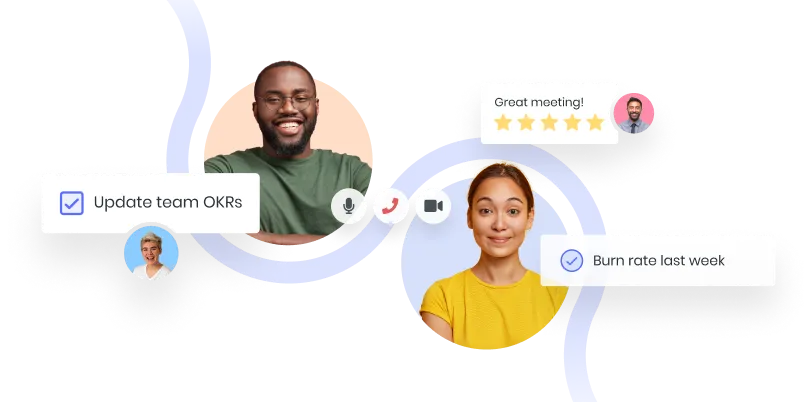.png)

Company Vision
- Start every all hands by reiterating the company vision — where we are at, what we believe, and where we are going.
Key Metrics
- Look at high-level metrics and explain what they mean in the context of the business and the broader market in general.
Customer/employee updates
- Invite leads from teams/departments to provide brief updates. Focus on high-level ideas and customer anecdotes.
- Make an effort to include new learnings — what has gone well, what hasn’t, and how that changes things.
Deep dive (Important topics & large-scale changes)
- Optional agenda item for occasionally drilling deep into something that is happening at the company. Examples include changes in strategy, positioning, and hiring/restructuring.
AMA (Ask me anything)
- Leave time at the end of the meeting to answer employee questions.
Appreciation reward
- Many companies like to honor teams or individuals during their All Hands. Often these awards are peer-nominated and do not come from the executive team.
Because the all-hands meeting brings everybody in the company together, it’s one of your most valuable meetings, but also one of your most costly. That’s why you should take extra effort to make sure you’re all-hands meeting is put together for maximum impact for everyone attending.
Company Vision — A moment of alignment
Start every all-hands agenda with a section that covers some aspect of the company vision. As a leader, you can never talk about the vision and purpose of your company enough.
Of course, what you share at your all-hands meeting is a vision for the company, something which has not been fully achieved. So, as you share where the company is headed, talk about specific things that everyone is doing now that contribute to getting there.
Key Metrics — Bring data to your meeting
Then, having set the stage, it’s time to move your meeting on to data, bringing in key metrics that illustrate where you’re at and where you are going. Your team doesn’t just want to hear what leadership thinks and wants — they want real numbers to back things up.
Don’t overload the data here though. While you may monitor a slew of metrics to understand where the company is at, select a few key ones that support the trends you’re seeing. With too many numbers, attendees of your meeting might start to tune out. And given that this is an all-staff meeting — you want to be effective every second.
Meeting Updates — High-level and strategic
To further emphasize the trajectory of your company, this is usually a good opportunity for updates from various teams and departments. Since the all-hands meeting is a longer meeting, switch up speakers and allow department heads to step forward and deliver their updates.
Make sure to ask your managers to include customer stories here when you can, as well as challenges that you have faced in what you have learned. It’s not very memorable just to give an update on projects. By bringing in some small stories or specific details, you’ll make the updates part of the meeting more compelling and memorable.
Deep Dive — Teach your team how to think
If there’s time, taking a deep dive into a single important topic toward the end of the meeting can be a way to engage the collective intelligence of your company, as well as teach everybody new ways to think about problems and how to solve them.
As a leader, carefully analyzing big challenges may seem part of your daily routine. Most of your team, though, doesn’t get to follow you through that process. This can lead to confusion around important decisions, even a lack of support if your team doesn’t understand why you’ve made a big decision the way you have.
By taking a deep dive, you not only justify decisions in greater detail, but you also help teach everyone at the all-hands meeting about your own decision-making process, including what information you collect, how you analyze it, and how you prioritize.
End your all-staff meeting on a high note
At this point, many all-hands meetings end, but it’s always good to end on a high note and one that improves the culture of the organization.
The Deep Dive may be that, but going deep on a topic can also be a rather heavy subject to end on. That’s why this sample agenda has an open ended question section, as well as an appreciation award for teams or individuals. One or both can be positive moments to end on.
After all, the all-hands meeting is a team meeting. What better way to wrap up the meeting than by involving the entire team in a Q&A session or by having peers congratulate each other?
More tips for leaders to run effective meetings
This all-hands meeting agenda template will help you run a more effective staff meeting, but it’s just a template. Here are some other articles on leadership, communication, and how to run meetings that you may find useful:
- How leaders run effective meetings: Meeting secrets from 5 top execs
- How to give a presentation during a meeting
- How to run effective meetings: Strategy, tactics, and the almighty agenda
- 11 Dos and don'ts of successful staff meetings (+3 Free agenda templates)
- Vital Meetings: Shorter, Fewer, Better (Short eBook)
- How to boost morale in uncertain times




.png)




